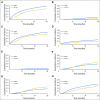Comparative Toxicities and Cost of Intensity-Modulated Radiotherapy, Proton Radiation, and Stereotactic Body Radiotherapy Among Younger Men With Prostate Cancer
- PMID: 29561693
- PMCID: PMC6008105
- DOI: 10.1200/JCO.2017.75.5371
Comparative Toxicities and Cost of Intensity-Modulated Radiotherapy, Proton Radiation, and Stereotactic Body Radiotherapy Among Younger Men With Prostate Cancer
Abstract
Purpose To compare the toxicities and cost of proton radiation and stereotactic body radiotherapy (SBRT) with intensity-modulated radiotherapy (IMRT) for prostate cancer among men younger than 65 years of age with private insurance. Methods Using the MarketScan Commercial Claims and Encounters database, we identified men who received radiation for prostate cancer between 2008 and 2015. Patients undergoing proton therapy and SBRT were propensity score-matched to IMRT patients on the basis of clinical and sociodemographic factors. Proportional hazards models compared the cumulative incidence of urinary, bowel, and erectile dysfunction toxicities by treatment. Cost from a payer's perspective was calculated from claims and adjusted to 2015 dollars. Results A total of 693 proton therapy patients were matched to 3,465 IMRT patients. Proton therapy patients had a lower risk of composite urinary toxicity (33% v 42% at 2 years; P < .001) and erectile dysfunction (21% v 28% at 2 years; P < .001), but a higher risk of bowel toxicity (20% v 15% at 2 years; P = .02). Mean radiation cost was $115,501 for proton therapy patients and $59,012 for IMRT patients ( P < .001). A total of 310 SBRT patients were matched to 3,100 IMRT patients. There were no significant differences in composite urinary, bowel, or erectile dysfunction toxicities between SBRT and IMRT patients ( P > .05), although a higher risk of urinary fistula was noted with SBRT (1% v 0.1% at 2 years; P = .009). Mean radiation cost for SBRT was $49,504 and $57,244 for IMRT ( P < .001). Conclusion Among younger men with prostate cancer, proton radiation was associated with significant reductions in urinary toxicity but increased bowel toxicity at nearly twice the cost of IMRT. SBRT and IMRT were associated with similar toxicity profiles; SBRT was modestly less expensive than IMRT.
Figures



Comment in
-
A Younger Man With Localized Prostate Cancer Asks, "Which Type of Radiation Is Right for Me?".J Clin Oncol. 2018 Jun 20;36(18):1780-1784. doi: 10.1200/JCO.2018.77.7235. Epub 2018 May 2. J Clin Oncol. 2018. PMID: 29718792 Free PMC article.
Similar articles
-
Stereotactic body radiation therapy versus intensity-modulated radiation therapy for prostate cancer: comparison of toxicity.J Clin Oncol. 2014 Apr 20;32(12):1195-201. doi: 10.1200/JCO.2013.53.8652. Epub 2014 Mar 10. J Clin Oncol. 2014. PMID: 24616315 Free PMC article.
-
Use, complications, and costs of stereotactic body radiotherapy for localized prostate cancer.Cancer. 2016 Aug 15;122(16):2496-504. doi: 10.1002/cncr.30101. Epub 2016 May 25. Cancer. 2016. PMID: 27224858 Free PMC article.
-
Cost-effectiveness analysis of SBRT versus IMRT for low-risk prostate cancer.Am J Clin Oncol. 2014 Jun;37(3):215-21. doi: 10.1097/COC.0b013e31827a7d2a. Am J Clin Oncol. 2014. PMID: 23275277
-
Proton versus photon-based radiation therapy for prostate cancer: emerging evidence and considerations in the era of value-based cancer care.Prostate Cancer Prostatic Dis. 2019 Dec;22(4):509-521. doi: 10.1038/s41391-019-0140-7. Epub 2019 Apr 9. Prostate Cancer Prostatic Dis. 2019. PMID: 30967625 Review.
-
Stereotactic body radiation therapy for prostate cancer-a review.Chin Clin Oncol. 2017 Sep;6(Suppl 2):S10. doi: 10.21037/cco.2017.06.05. Chin Clin Oncol. 2017. PMID: 28917248 Review.
Cited by
-
Systematic study of the iodinated rectal hydrogel spacer material discrepancy on accuracy of proton dosimetry.J Appl Clin Med Phys. 2022 Oct;23(10):e13774. doi: 10.1002/acm2.13774. Epub 2022 Sep 15. J Appl Clin Med Phys. 2022. PMID: 36106986 Free PMC article.
-
Enhancing nanoparticle accumulation in two dimensional, three dimensional, and xenograft mouse cancer cell models in the presence of docetaxel.Sci Rep. 2022 Aug 5;12(1):13508. doi: 10.1038/s41598-022-17752-5. Sci Rep. 2022. PMID: 35931743 Free PMC article.
-
Dose prescription and reporting in stereotactic body radiotherapy: A multi-institutional study.Radiother Oncol. 2023 May;182:109571. doi: 10.1016/j.radonc.2023.109571. Epub 2023 Feb 22. Radiother Oncol. 2023. PMID: 36822361 Free PMC article.
-
Analysis of Gastrointestinal Toxicity in Patients Receiving Proton Beam Therapy for Prostate Cancer: A Single-Institution Experience.Adv Radiat Oncol. 2018 Aug 13;4(1):70-78. doi: 10.1016/j.adro.2018.08.002. eCollection 2019 Jan-Mar. Adv Radiat Oncol. 2018. PMID: 30706013 Free PMC article.
-
A Younger Man With Localized Prostate Cancer Asks, "Which Type of Radiation Is Right for Me?".J Clin Oncol. 2018 Jun 20;36(18):1780-1784. doi: 10.1200/JCO.2018.77.7235. Epub 2018 May 2. J Clin Oncol. 2018. PMID: 29718792 Free PMC article.
References
-
- Kuban DA, Tucker SL, Dong L, et al. : Long-term results of the M. D. Anderson randomized dose-escalation trial for prostate cancer. Int J Radiat Oncol Biol Phys 70:67-74, 2008 - PubMed
-
- Slater JD, Rossi CJ, Jr, Yonemoto LT, et al. : Proton therapy for prostate cancer: The initial Loma Linda University experience. Int J Radiat Oncol Biol Phys 59:348-352, 2004 - PubMed
Publication types
MeSH terms
Grants and funding
LinkOut - more resources
Full Text Sources
Other Literature Sources
Medical

